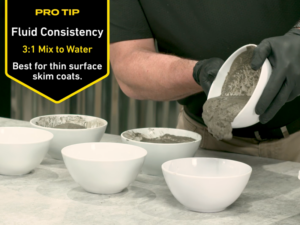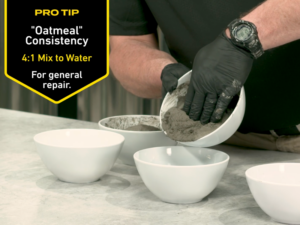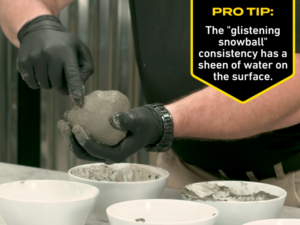View the Companion Pro Tips Video >>
Wait…I Get to Customize My Mix?
No two concrete repair projects are quite alike, so it’s rare that you’ll be able to take a “by-the-book” approach every time.
A bit of improvisation and customization are often required, especially when it comes to the consistency of your repair materials.
Luckily, Sakrete repair mixes are designed to be mixed into a range of consistencies to suit the needs of different projects from simple skim coats to complex vertical repairs.
In this post, we’ll explore how to adapt your materials to match the specific needs of your project and the three common states of concrete material consistency that you need to be familiar with: fluid (aka “loose), plastic (aka “oatmeal”), and sculptable (aka “the glistening snowball).
Loose or Fluid:
Approximately 3:1 Mix to Water
 This consistency is akin to a slurry, making it ideal for applications like skim coating over a large surface area. Use it when you need to fix minor imperfections in the slab and create a smooth coating without changing the height of the slab too much.
This consistency is akin to a slurry, making it ideal for applications like skim coating over a large surface area. Use it when you need to fix minor imperfections in the slab and create a smooth coating without changing the height of the slab too much.
Achieving this state ensures that the material flows easily, making it suitable for surface-level repairs.
Oatmeal or Plastic:
Approximately 3:1 to 4:1 Mix to Water
 Think of this consistency as similar to oatmeal—not too fluid but still highly malleable. It’s plastic state is ideal for most concrete repairs because it’s easy to work with, but can still hold its shape in order to allow for tougher repairs like fixing broken corners or edges.
Think of this consistency as similar to oatmeal—not too fluid but still highly malleable. It’s plastic state is ideal for most concrete repairs because it’s easy to work with, but can still hold its shape in order to allow for tougher repairs like fixing broken corners or edges.
Most concrete patching work falls into this category, and small variations between a little more water or a little more mix will get you where you need to be for a particular job.
Remember, just a few drops of water can make a big difference in the consistency, so be patient and adjust slowly!
Sculptable (Glistening Snowball):
Approximately 5:1 Mix to Water
 This is the most rigid and dry state, allowing for molding, shaping and the best vertical bond.
This is the most rigid and dry state, allowing for molding, shaping and the best vertical bond.
Achieving this concrete material consistency requires precise mixing and is often most easily achieved by mixing with your hands (while wearing latex or nitrile gloves, of course).
The term “glistening snowball” is a good visualization for the consistency you’re shooting for. The mix should be dry enough to be packed together into a firm “snowball” without sagging, but should also retain a sheen of water on the outside.
The presence of water on the surface is crucial; if it’s absent, the mix is too dry and the patch may fail.
Know Your Mix, Get the Job Done Right.
In practice, concrete repair projects often require a combination of these consistency states, depending on the scope and nature of the repairs.
By understanding the three primary states of concrete repair materials —loose or fluid, oatmeal-like, and sculptable—and knowing when to apply each, you can tackle a wide range of repair scenarios with confidence.